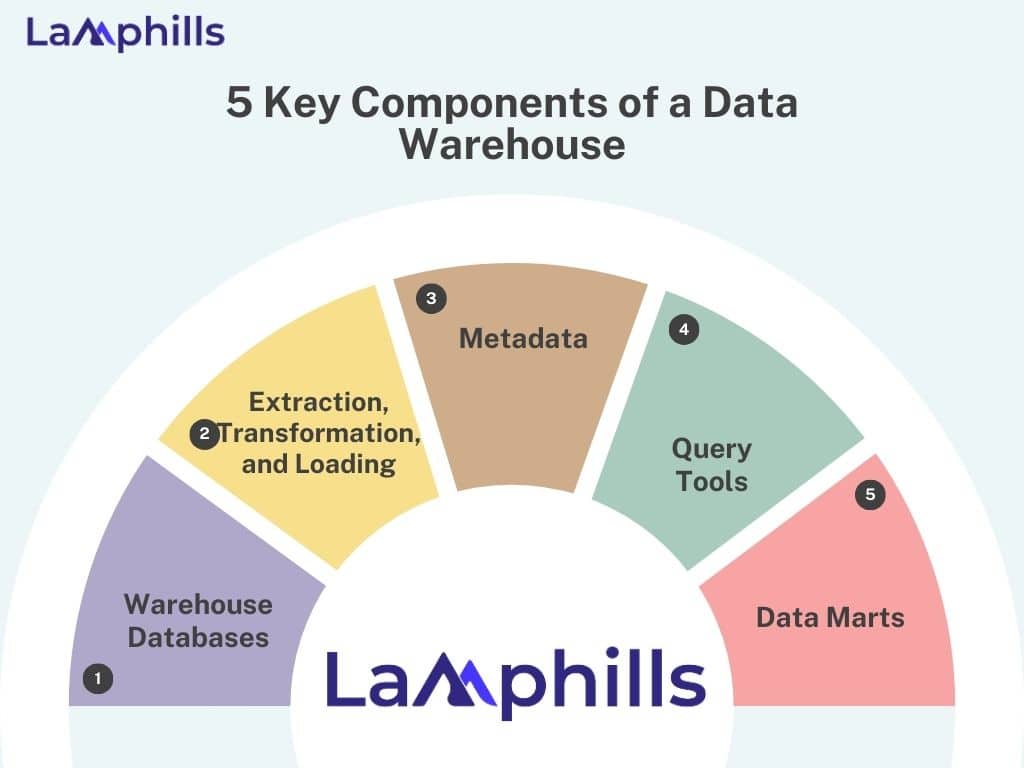Imagine you’re running a marketing campaign and must pull data from Facebook ads, Google Analytics, and your CRM system. You’re juggling spreadsheets, dealing with missing data, and trying to piece together a complete picture of your marketing performance. Sounds familiar? This was my reality until I discovered the game-changer: data warehouse marketing.
One day, I was neck-deep in analytics, trying to track the R.O.I. of our latest campaign. It was a nightmare, but then I heard about this revolutionary approach that promised to simplify everything. Curious? Trust me, what I learned will forever change how you handle marketing data. Let’s dip into the world of data warehouse marketing and uncover how it can transform your marketing strategy.
KeyPoints
- A marketing data warehouse consolidates data from various sources like CRM systems, web analytics, and advertising platforms into a single cloud-based repository.
- Unlike traditional storage methods, data warehouses offer scalable and cost-effective solutions for storing large volumes of data over extended periods.
- Data warehouses organize data into structured tables, making it easier for marketers to query and analyze specific datasets quickly.
- Integrating a data warehouse with BI tools accelerates the generation of actionable insights and reports.
- Implementing robust security measures such as encryption and access controls ensures the protection of sensitive customer data within the data warehouse. Compliance with data privacy regulations like GDPR and HIPAA is also simplified, helping businesses maintain trust and adhere to legal requirements.
What is a Marketing Data Warehouse?
A marketing data warehouse is a cloud-based place to store and analyze all your marketing data from different sources. It allows marketing teams to bring together data from various platforms, like advertising channels (Facebook and Google), web analytics tools (Google Analytics), and CRM systems (HubSpot and Salesforce).
Why Use a Marketing Data Warehouse?
Compared to other ways of storing and analyzing data, marketing data warehouses offer several benefits:
These cost-effective and scalable warehouses offer affordable storage that can grow as your data grows. Plus, they let you centralize data from different sources, making it easier to get a comprehensive view of your marketing efforts. For instance, I remember when our team used multiple spreadsheets to track campaigns from different platforms. It was chaotic! Moving to a data warehouse simplified everything and saved us so much time.
Read: STEPS TO DEVELOPING A BUSINESS DEVELOPMENT PLAN: The Ultimate Guide
How Does a Marketing Data Warehouse Work?
A data warehouse comprises structured tables that make it easy to quickly find the data you need for reports or analysis. Most data warehouses use SQL, a language for managing and querying data.
How to Build a Marketing Data Warehouse?

DC Studio
Step 1: Define Your Data Sources and Objectives
First, figure out where your data is coming from. This includes CRM systems, web analytics, ad platforms, and social media. Then, outline your marketing goals and the key metrics you want to track. This will set the stage for everything else you do.
Step 2: Pick the Right Data Storage Solution
Next, choose a storage solution for your data warehouse. If you need to be more technical, use a cloud-based option like Snowflake, Google BigQuery, Amazon Redshift, or Microsoft Azure. The cloud providers manage these, so you don’t have to worry about technical maintenance. If you want an even simpler solution, try another site with an in-built Snowflake warehouse and other tools to help manage your data.
Step 3: Create a Data Model or Schema
Design the blueprint that maps your data sources to your analytical needs. Decide which raw data you can use directly and which needs to be transformed or cleaned. This helps ensure your data is ready for analysis. For a quick guide, check out online courses or resources on data modelling. Here is a checklist that can help you create a model or schema.
Step 4: Design and Implement Your Data Pipelines
Set up an ETL (Extract, Transform, Load) process to move data from various sources into your warehouse. Use tools with pre-built connectors to make this easier. For example, checking sites offering over 250 pre-built connectors requires just inputting your credentials to transfer data. Ensure all raw data meets your schema requirements.
Step 5: Ensure Data Security
Protect sensitive customer data with robust security measures like encryption and regular access key rotations. This keeps your data safe and ensures compliance with regulations like G.D.P.R. and HIPAA. Choose data warehouse vendors that offer built-in security features.
Step 6: Maintain and Monitor Regularly
Set up a routine for data backup, system updates, and performance checks. Use monitoring tools to track the health of your data pipeline and warehouse. There are platforms that provide a dashboard to monitor job performance and identify errors, making maintenance easier.
Step 7: Validate Data (Quality Assurance)
Ensure your data’s accuracy and quality with validation processes throughout the ETL pipeline. Address any data anomalies or errors promptly. No-code transformation tools can help you clean data quickly, even without coding skills.
Step 8: Data Accessibility
Make sure the relevant teams and stakeholders can access the data they need. Set up role-based access control (RBAC), export data to a B.I. tool, or build data apps for more straightforward analysis. Use data visualization tools and reporting dashboards to make insights accessible to everyone, even those without technical skills.
Step 9: Continuously Improve
Regularly evaluate your data warehouse architecture to find areas for improvement. Look for ways to speed up job performance, fill data gaps, and adapt to new data sources or business needs. Keep enhancing your data infrastructure to stay up-to-date with emerging technologies.
What Are the 5 Key Components of a Data Warehouse?

#1. Warehouse Databases
- Analytics Database: These databases are designed specifically to handle and manage the analytics part of data storage, ensuring that complex data analysis can be performed efficiently.
- Cloud-based Database: Hosted on the cloud, these databases eliminate the need for physical hardware, making it easier to establish and manage your data warehouse. They offer scalability and flexibility that on-premise solutions cannot match.
- Central Database: This type of database stores all the data related to your business in one central location, making it easier for analysts to generate comprehensive reports and insights.
- Typical Relational Databases: Data in these databases is organized into rows and columns, forming tables that are easy to manage and query. This traditional structure supports robust data handling and efficient querying.
#2. ETL (Extraction, Transformation, and Loading)
ETL is a crucial component of a data warehouse, involving three main processes:
- Extract: This step involves copying raw data from various sources into a staging area. The data collected can be structured or unstructured, which is essential for gathering all necessary information.
- Transform: In the staging area, the raw data is cleaned, filtered, validated, and prepared for loading. This ensures the data is accurate, formatted correctly, and ready for analysis.
- Load: Finally, the transformed data is moved from the staging area to the target data warehouse. This process starts with an initial bulk load, followed by incremental updates as data changes, ensuring the data warehouse remains current.
#3. Metadata
Metadata is data about data. It helps in understanding the data’s context, nature, and structure. Here’s why it’s important:
- Contextual Understanding: Metadata provides the context for the data, making it easier to understand and use effectively in various analyses.
- Ease of Search and Retrieval: Metadata helps users search for and retrieve data efficiently, saving time and improving accuracy.
- Unlocking Hidden Content: Metadata unlocks the hidden content of data, offering deeper insights and a better understanding of the underlying information.
#4. Query Tools
These tools allow us to interact with the data warehouse and retrieve relevant information. They include:
- Query and Reporting Tools: These tools are used to generate business reports. Managed query tools protect users from SQL complexities by adding a security layer, simplifying the reporting process.
- Online Analytical Processing (OLAP) Tools allow selective data retrieval and analysis from various perspectives, working with multidimensional data models to provide comprehensive insights.
- Data Mining Tools: Data mining tools analyze large datasets to find patterns and relationships, helping businesses uncover valuable insights that might not be apparent through simple queries.
#5. Data Marts
A data mart is a focused subset of a data warehouse tailored for a specific department or purpose. It offers several benefits:
- Quick Decision-Making: Summarized data in data marts helps stakeholders make informed decisions quickly by providing relevant, concise information.
- Efficient Information Retrieval: Data marts contain the most relevant information, making data retrieval faster and more efficient for specific departmental needs.
- Streamlined Decisions: They help make streamlined decisions by providing access to specific data, ensuring stakeholders have the precise information they need.
- Easy Management: With fewer data tables, data marts are easier to manage and update without causing significant disruptions, making them a practical solution for specific business areas.
What Is Data Warehousing in CRM?
To use data warehousing for CRM effectively, you must define your business goals and requirements, select your data sources and integration methods, design your data model and architecture, implement data quality and security measures, and monitor and optimize your data warehouse. You should identify what kind of customer data you need, how to use it, and what outcomes you want to achieve. Choose the relevant and reliable data sources that can provide you with the customer data you need. Design your data model and architecture to support your analytical needs and queries. Validate, clean, and enrich your data. Encrypt, backup, and audit your data.
Track and measure your data warehouse performance, usage, and results. Update and improve your data warehouse as your business needs and objectives change. Data warehousing for CRM can help you leverage customer data to gain insights and improve customer relationships; however, following the best practices is essential for achieving desired results.
Read: The Best Brand Collaborations to Inspire You in 2024 (+ Practical Examples)
What Are the Benefits of Data Warehouses in Marketing?

DC Studio
The primary purpose of a marketing data warehouse is to improve how data is stored for marketing analytics. However, it also offers other benefits that can enhance both your marketing efforts and overall data operations:
#1. Create a Single Source of Truth
A marketing data warehouse centralizes data in one place. When all teams, like marketing and sales, use the same customer data and metrics, it promotes a shared understanding of customer behaviour and campaign effectiveness. This breaks down barriers between teams and aligns different stakeholders. The data model (schema) and architecture of the data warehouse ensure this single source of truth is accurate and reliable without duplicated or inconsistent information.
#2. Enhance Informed Decision-Making
By storing historical data, a marketing data warehouse allows analysis of past marketing campaigns and performance metrics. This historical perspective helps make informed decisions and refine marketing strategies based on past insights and trends.
Improved decisions boost marketing results and positively impact business metrics like R.O.I. (Return on Investment) and R.O.A.S. (Return on Advertising Spend), ultimately improving profitability.
#3. Speed Up Data-Driven Marketing
Integrate the marketing data warehouse with business intelligence (B.I.) tools and reporting systems to expedite the creation of actionable insights. The warehouse’s data structure is designed to seamlessly integrate with B.I. tools, facilitating quick generation of data visualizations and dashboards. Advanced data warehouse solutions automate report generation, allowing more focus on developing effective marketing strategies rather than creating dashboards.
#4. Track and Optimize Marketing Campaigns
By consolidating data from various sources, the marketing data warehouse provides a unified view of customer interactions across all channels in the customer journey.
This comprehensive view accurately attributes which marketing campaigns contribute most to successful conversions. It enables you to allocate time and budget more effectively to campaigns that deliver the best results.
Compared to other storage and analytics solutions, a marketing data warehouse offers integrated benefits that streamline data handling, improve analytics accuracy, and empower more effective marketing decision-making.
Related Post
What Is Lead Generation Data: Purpose, Analysis, Tools and Best Strategy
STEPS TO DEVELOPING A BUSINESS DEVELOPMENT PLAN: The Ultimate Guide
Building an Effective Crisis Management Plan for Your Business






